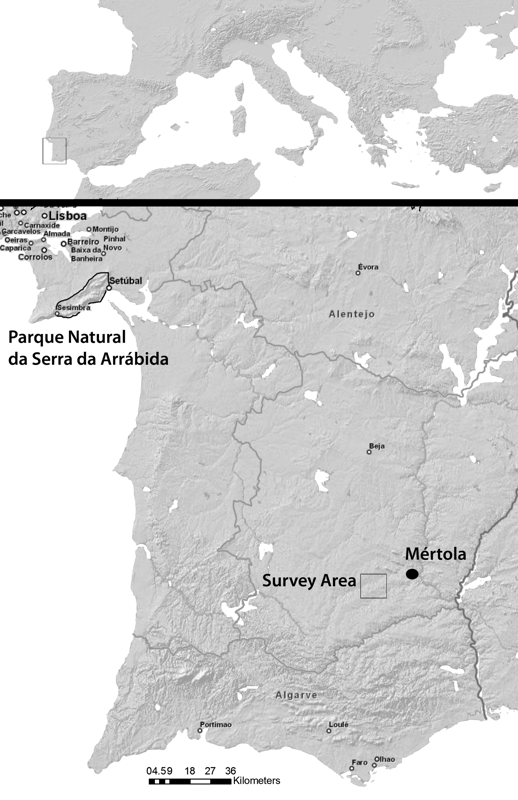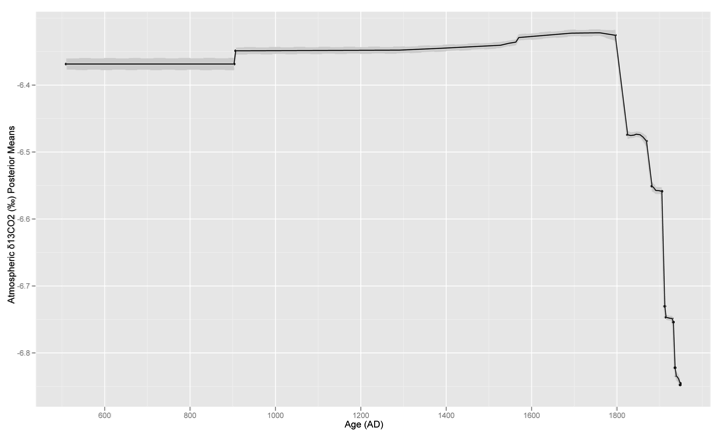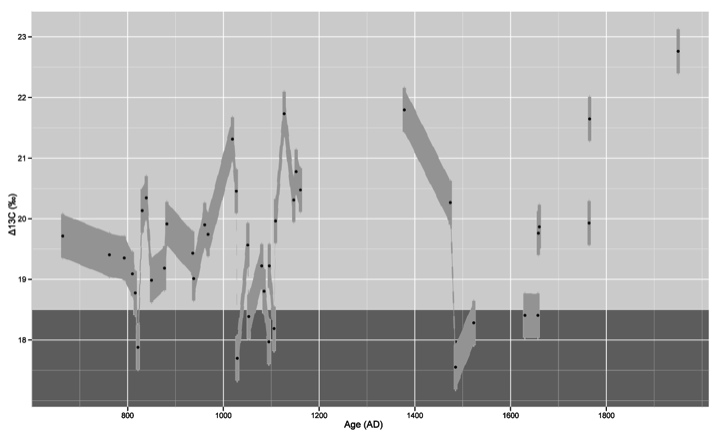The Use of Radiocarbon-Derived Δ13C as a Paleoclimate Indicator: Applications in the Lower Alentejo of Portugal
Drake, B.L., Hanson, D.T., Boone, J.L.
2012 The Use of Radiocarbon-Derived Δ13C as a Paleoclimate Indicator: Applications in the Lower Alentejo of Portugal, Journal of Archaeological Science 39: 2888 - 2896
Drake, B.L., Hanson, D.T., Boone, J.L.
2012 The Use of Radiocarbon-Derived Δ13C as a Paleoclimate Indicator: Applications in the Lower Alentejo of Portugal, Journal of Archaeological Science 39: 2888 - 2896

Archaeologists regularly receive δ13C values with their radiocarbon dates. These values can be used to calculate ∆13C values, which are great for understanding past drought. I worked with Dr. James Boone and Dr. David Hanson of the University of New Mexico to explore applying these data to understanding the abandonment of the rural Lower Alentejo of Portugal during the Medieval Warm Period.

Posterior means of atmospheric values of δ13CO2 reconstructed from combined EPICA and Law Dome records. A slight increase in atmospheric δ13CO2 are seen preceding the beginning of the Medieval Warm Period, potentially suggesting a change in global carbon sinks and sources at that time. The sharp decline in atmospheric δ13CO2 values beginning in the 1800’s is attributable to anthropogenic carbon emissions; modern values have surpassed -8.0‰ (Drake et al. 2012).

Time-series of 13C discrimination (Δ13C) in the Lower Alentejo, plotted along calibrated median values... The light grey band represents a 95% confidence interval for Δ13C. There is evidence for arid conditions lasting from the mid 11th to early 12th centuries AD and again the late 15th to mid 17th centuries AD due to a cluster of low Δ values. These drier conditions may be associated with the Medieval Warm Period, which lasted from 1000 to 1200 AD, though the first 100 years show the strongest warming signal. No dates were collected between from the mid 12th through the early 15th centuries AD. There is evidence for human population abandonment and widespread soil erosion preceding that period. The dark grey portion of the grid at the bottom of the figure (Δ13C < 18.5‰) represents minimum Δ13C values of Olea europea, Quercus coccifera, Cistus albidus and monspelensis that occurred during the 2001 drought year (Werner and Máguas 2010) (Drake et al. 2012).
The data indicated a period of aridity during the Medieval Warm Period that occurred before the rural collapse. I spoke with Dr. Scott Worman, and he thought the aridity might have influenced the subsequent soil erosion that occurred in the area. It seems like the soil may have been desiccated, leaving it vulnerable to washing away during flooding events. There does seem to be an uptick in moisture beginning in AD 1100, so it is an intriguing possibility.
You can read more at the Journal of Archaeological Science's website, or by visiting my Academia.edu page. You can also download the R Code to run the analysis yourself.
You can read more at the Journal of Archaeological Science's website, or by visiting my Academia.edu page. You can also download the R Code to run the analysis yourself.







